| Image search results - "Mars" |

TIBERIUS - Provincial AE30 - 18/37 - Utica (Zeugitana)
Obv.: TI CAESAR DIVI AVG F AVGVST IMP VIII
Bare head left
Rev.: C VIBIO MARSO PR COS C CASSIVS FELIX A II VIR
Livia seated left, holding patera and sceptre. D D P P across field (Decreto Decurionvm Permissu Proconsulis)
g. 13,9 mm. 29,5
Sear GIC 302
Maxentius
|
|

Commodus - Denarius - 181/182 . Mint of Rome
Ob.: M COMMODVS ANTONINVS AVG; Laureate head right
Rev.: TR P VII IMP IIII COS III P P; Mars walking right, holds trophy and spear.
gs. 3,8 mm. 17,8
Cohen 821Maxentius
|
|

AR Denarius - TI. VETVRIVS - 137 BC. Gens Veturia - Mint of Rome
Obv.: Helmeted bust of Mars right, X and TI. VE (VE in monogram) behind
Rev.: Youth kneeling holding pig, between two soldiers; ROMA above
Gs. 3,6 mm. 18,3
Crawf. 234/1, Sear RCV 111
Some dies of this coin have a crude style. Maxentius
|
|

Denarius - 109-108 BC.
Q. LVTATIVS CERCO - Gens Lutatia
Obv.: ROMA CERCO, helmeted head of Roma (or Mars) right. XVI in monogram behind
Rev.: Q LVTATI, galley right within oak wreath.
Gs. 3,7 mm. 17,4
Crawford 305/1, Sear RCV 182.
Maxentius
|
|

Denarius - 82 BC.
L. MARCIVS CENSORINVS - Gens Marcia
Obv.: Laureate head of Apollo right
Rev.: L CENSOR, the satyr Marsyas, standing left with wineskin over shoulder; behind him, column surmounted by Victory.
Gs. 3,7 mm. 18,3
Craw. 363/1d, Sear RCV 281
Maxentius
|
|

Denarius - 88 BC.
CN. CORNELIVS LENTVLVS CLAVDIANVS - Gens Cornelia
Obv.: Helmeted bust of Mars right, seen from behind, with spear and parazonium Rev.: Victory in biga right. In ex. CN LENTVL
Gs. 3,7 mm. 16,7x18,3
Crawford 345/1; Sear RCV 254
Maxentius
|
|

TRAJAN - Denarius - 116 AD.
Obv.: IMP CAES NER TRAIAN OPTIM AVG GER DAC, laureate draped bust right
Rev.: PARTHICO P M TR P COS VI P P SPQR, Mars advancing right with trophy & spear.
Gs. 3,3 mm. 19,1
Cohen 190 Maxentius
|
|
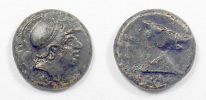
Anonymous AE Litra. 241-235 BC. (Grueber, half-litra: 312/290 BC)
Romano-Campanian
Obv.:Helmeted, beardless head of Mars right
Rev.:Head of horse right with bridle. A sickle behind, ROMA below.
Gs. 3,4 mm. 15,2
Crawford 25/3, Sear RCV 594, BMRRC II 64
Maxentius
|
|

Denarius, 112/111 B.C. Rome Mint
CN. CORNELIVS CN.F. BLASIO - Gens Cornelia
Obv.:Mars, helmeted, right (or Scipio Africanus), CN. BLASIO CN.F. before (var. N retrograde), bucranium behind. XVI (in monogram) above
Rev.: Juno, Jupiter being crowned by Minerva; letter Θ in field, ROMA in ex.
Gs. 3,25 mm. 20,6x18,4
Crawford 296/1c, Sear RCV 173, Grueber 626
Maxentius
|
|

Denarius - 103 BC.
Q. MINVCIVS M.f. THERMVS - Gens Minucia
Obv.:Helmeted head of Mars (or Rome) left
Rev.: Q. THERM (THE in monogram) M.F. (in monogram) below two warriors in combat, one on left protecting a fallen man.
Gs. 4 mm. 19,37x20,10
Crawf. 319/1, Sear RCV 197
Maxentius
|
|
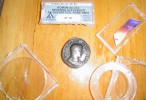
Free at last, free at last.rexesq
|
|

Severus Alexander. AD232. AE Sestertius. Reverse.
obv: IMP ALEXANDER PIVS AVG - Laureate bust right, seen from front, draped and cuirassed.
rev: MARS VLTOR - Mars with spear and shield in the 'Ready-for-Action' position.
'S C' to either side of Mars.
22.3 grams.rexesq
|
|

Severus Alexander. AD232. AE Sestertius. Obverse.
obv: IMP ALEXANDER PIVS AVG - Laureate bust right, seen from front, draped and cuirassed.
rev: MARS VLTOR - Mars with spear and shield in the 'Ready-for-Action' position.
'S C' to either side of Mars.
22.3 grams.rexesq
|
|

Severus Alexander. AD232. AE Sestertius. Obverse.
obv: IMP ALEXANDER PIVS AVG - Laureate bust right, seen from front, draped and cuirassed.
rev: MARS VLTOR - Mars with spear and shield in the 'Ready-for-Action' position.
'S C' to either side of Mars.
22.3 grams.
**Photo w/ Flash
---
-rexesq
|
|

Severus Alexander AD 232 AE Sestertiusrexesq
|
|

Severus Alexander AD 232 AE Sestertiusrexesq
|
|

Emperor Severus Alexander. AD232. AE Sestertius. Reverse, cut.
obv: IMP ALEXANDER PIVS AVG - Laureate bust right, seen from front, draped and cuirassed.
rev: MARS VLTOR - Mars with spear and shield in the 'Ready-for-Action' position.
'S C' to either side of Mars.
22.3 grams.rexesq
|
|

Emperor Severus Alexander. AD232. AE Sestertius. Reverse, cut.
obv: IMP ALEXANDER PIVS AVG - Laureate bust right, seen from front, draped and cuirassed.
rev: MARS VLTOR - Mars with spear and shield in the 'Ready-for-Action' position.
'S C' to either side of Mars.
22.3 grams.
--------------------------
Fantastic 'MARS ULTOR' reverse!rexesq
|
|

Emperor Severus Alexander. AD232. AE Sestertius. Reverse.
obv: IMP ALEXANDER PIVS AVG - Laureate bust right, seen from front, draped and cuirassed.
rev: MARS VLTOR - Mars with spear and shield in the 'Ready-for-Action' position.
'S C' to either side of Mars.
22.3 grams.
--------------------------
Fantastic 'MARS ULTOR' reverse!!rexesq
|
|

Emperor Severus Alexander. AD232. AE Sestertius. Obverse.
obv: IMP ALEXANDER PIVS AVG - Laureate bust right, seen from front, draped and cuirassed.
rev: MARS VLTOR - Mars with spear and shield in the 'Ready-for-Action' position.
'S C' to either side of Mars.
22.3 grams.rexesq
|
|
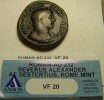
Emperor Severus Alexander. AD232. AE Sestertius. Obverse.
obv: IMP ALEXANDER PIVS AVG - Laureate bust right, seen from front, draped and cuirassed.
rev: MARS VLTOR - Mars with spear and shield in the 'Ready-for-Action' position.
'S C' to either side of Mars.
22.3 grams.rexesq
|
|

POSTUMUS - 260/268 AD -Billon Antonianius - Lugdunum mint
Obv:IMP C POSTVMVS P F AVG, Radiate, draped and cuirassed bust right
REv: VIRTVS AVG, Mars standing right, holding spear and leaning on shield
Gms 3,1, mm. 23,3
RIC 93, Cohen 419
Maxentius
|
|

Apameia in Phrygia, 133-48 B.C, AE17mm, Obv. Turreted bust of Artemis right, bow and quiver at shoulder. Rev. Naked Marsyas advancing right, playing double flute, to right, KHΦIΣO - ΣKAY
Sear 5122; BMC 25.85,91-3Lee S
|
|

AE sestertius. Struck under Claudius, circa 50-54 AD, uncertain eastern provincial mint located in the modern-day Balkans.
Obv : TI CLAVDIVS CAESAR AVG F BRITANNICVS, draped bust left.
Rev : - No legend, Mars advancing left, holding spear and shield, SC in fields. 35mm, 19.4g. Extremely Rare.
Ref : BMCRE 226
Cohen 2
RCV 1908, valued at $32,000 in Fine, which is a few multiples greater than any other sestertius issued during the several centuries the denomination was in use.
A large number of the surviving examples of this series (one may even suggest a majority of them), due to their rarity, have been subjected to modern alteration techniques such as smoothing, tooling, and repatination. As such, it's actually pleasant to see a bit of field roughness and a 'plain brown' patina of old copper on this example, evidence that it is just as ugly as it was the day it was last used in circulation back in Ancient Rome.
Britannicus, originally known as Germanicus after Claudius' older brother, was the emperor's original intended heir and natural son. Machinations by Agrippina II eventually saw Britannicus supplanted by her own son Nero, (by Lucius Domitius Ahenobarbus) who took the throne upon Claudius' suspicious death. Britannicus himself died a few years later, reportedly poisoned by his step-brother. The future emperor Titus and Britannicus were close friends, and Titus became quite ill and nearly died after eating from the same poisoned dish that killed Britannicus.R. Smits
|
|

Detail of shield decorated with Emperor on horseback charging left, holding spear appearing to impale bound captive seated left.gordian_guy
|
|

Roman Imperial
Severus Alexander, AD 222 - 235
Obverse: Bust of Severus Alexander Facing Right
Reverse: Mars Advancing right, shield in left hand, spear in right
Mass: 2.91 grams, C. 161; RIC 246paul1888
|
|

Roman Republic - P. Satrienus. Silver denarius (3,82 g., 18 mm.) Minted in Rome in 77 B.C.
Helmeted head right of young Mars, numeral behind (XXXII). /
ROMA She-wolf walking left. P•SATRIE/NVS in exergue.
Sear 319; Satriena 1; Cr. 388/1b.paul1888
|
|

ROMAN EMPIRE: Severus Alexander, AD 222-235, AR Denarius (19mm, 3.27g), Rome Mint, AD 232. Obverse: IMP ALEXANDER PIVS AVG; laureate and draped bust of Severus Alexander to right. Reverse: MARS VLTOR; Mars advancing right, holding spear in his right hand and shield in his left. BMC 837. Cohen 161. RIC 246. Ex: Naumann Auktion 111, 04.12.2021, lot 873.paul1888
|
|

Trajan, 98-117. AR Denarius Rome. (19 mm, 3.02 g), Rome. Obv. IMP CAES NER TRAIAN OPTIM AVG GERM DAC Laureate, draped, and cuirassed bust of Trajan right. Rev. PARTHICO P M TR P COS VI P P S P Q R Mars advancing right, holding spear and trophy. RIC 331 var. (no cuirass); BMCRE III, 616 var. (same).paul1888
|
|

2nd - 1st Century BC, IRON AGE BRITAIN, Tribe: Cantii, AE Potin, Minted between 100 and 30 BCObverse: No legend. Crude outline of head facing right; pellet within circle in centre.
Reverse: No legend. Crude lines representing a bull facing left, crescents above.
Flat Linear type, Class 1
Found, Thames Valley region, England
Diameter: 17mm | Weight: 1.9gms | Axis: 3h
BMC: 667-714 | SPINK: 63
The Cantii produced the first coins to be actually made in Britain.
These coins were cast in strips which were then cut into separate coins and as a result often retain characteristic cut edges from the runlets which joined them together.
THE CANTII (or Cantiaci)
The Cantii (after whom Kent and Canterbury are named) were the major tribal group in the South East region of England, bordered by the Atrebates, Regni and Catuvellauni.
This region was heavily influenced by continental cultures on the periphery of the early Roman world and this resulted in the Cantii producing the first coins actually made in Britain. These are known as “potins” and they were produced between the mid 2nd to the mid 1st century BC. The earliest versions are known as Kentish Primary, or Thurrock, types. Comparatively the later types, like those from the recently discovered Hillingdon Hoard, are of the “flat linear” type, which uses simplified and abstracted images. Similar coins from the late Iron Age have been found, but in much smaller quantities.
The word “potin” is of French origin and is used to describe these early coins which were cast in clay moulds from a copper alloy with a high tin content. They would have been shiny and silver-coloured when new, and though occasionally examples have turned up which retain this colouration, most coins by the time they get dug up have a characteristic black patina from tin oxidation. These were cast in strips which were then cut into separate coins and as a result often retain characteristic cut edges from the runlets which joined them together. The moulds themselves were made using “master” matrices of copper alloy which were cast with the design for one side of a coin in high relief and pressed into the clay. A rare example of a mould of this type was found a few miles west of the Surrey border in Hampshire.
The designs of the majority of potins found in England derive ultimately from coins produced in the Greek colonial Mediterranean city of Massalia (modern Marseilles) in southern Gaul in the late 4th century BC. These coins featured a head of Apollo on the obverse and a charging bull on the reverse. They were originally imported from the continent and later locally copied in the mid 2nd century BC, in the form of what are known as “Thurrock” types, which adhere closely to the original design. Later forms, known as “flat linear” types, greatly simplified this design into deep abstraction, ultimately reducing the head of Apollo to an outline and the bull to a trapezoidal arrangement of lines
We don’t know what these coins were called by the people who made them, or what they were worth in fiscal terms, but they are generally only found in south east England, which probably reflects the limits of the political and economic influence of the Cantii themselves. It isn't even clear what the role of these Iron Age coins actually was, though it is likely that they assisted in the maintenance of some kind of social power structure. Coins were not generally used as day to day currency by the people of Britain in the 1st and 2nd centuries BC, so apart from any monetary transactions, their range of uses probably included the storage of wealth, use as political tribute, and / or votive objects used as offerings to the gods.
CLICK ON MAP BELOW TO ENLARGE IT
 *Alex *Alex
|
|

3 Tiberius, Utica, Zeugitana, Ex John Quincy Adams CollectionBronze dupondius, RPC I 739, F, holed, 13.158g, 29.8mm, 90o, Zeugitana, Utica mint, 298 - 30 A.D.; obverse TI CAESAR DIVI AVG F AVG IMP VIII, bare head left; reverse C VIBIO MARSO PRCOS III C SALLVSTIVS IVSTVS II, Livia seated right, scepter in left, patera in extended right, M - M / I - V across fields; with John Quincy Adams Collection tag from the Stack's Sale; scarce
RI0001
Ex John Quincy Adams Collection, 6th President of the United States, and His Descendants, ex Massachusetts Historical Society Collection, ex Stack’s Sale , 5-6 March 1971, lot 763.
Purchased from FORVMSosius
|
|

88cfCarausius 287-93AD
Antoninianus
Obv “IMP CARAVSIVS P AVG”
Radiate, draped and cuirassed bust right
Rev “MARS VICTOR”
Mars walking right holding spear with trophy over shoulder
Unmarked mint
-/-//[III]
RIC - (cf 88 & 844)
Reverse die duplicate of Normanby Hoard 1582 and 1583. Its is evident from the form of the mint mark (off flan on this specimen) that the die engraver was copying the reverse of a Lyon mint coin of Probus.
mauseus
|
|

1 Gordian IIIGordian III
AR Antonianus, Rome Mint
243-4 AD
O: IMP GORDIANVS PIVS FEL AVG
R: MARS PROPVG, Mars advancing right, holding transverse spear and shield
RIC IV-3 145; Cohen 155; Sear (5) 8623 Sosius
|
|

1 Gordian IIIGordian III
AR Antonianus, Rome Mint
243-4 AD
O: IMP GORDIANVS PIVS FEL AVG
R: MARS PROPVG, Mars advancing right, holding transverse spear and shield
RIC IV-3 145; Cohen 155; Sear (5) 8623Sosius
|
|
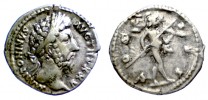
18 Marcus Aurelius MARCUS AURELIUS
AR Denarius
170-171 AD
M ANTONINVS AVG TR P XXV, laureate head right / COS III, Mars advancing right with spear & trophy.
RSC 126, RIC 231, Sear5 #4886
Ex D. Loates Fine Art
RI0102Sosius
|
|

180cfCarausius 287-93AD
Antoninianus
Obv “IMP CARAVS....... ”
Radiate, draped and cuirassed bust right
Rev “VIRT[VS AVG]”
Mars walking right holding spear with trophy over shoulder
London mint
F/O//ML
RIC - (cf 180)mauseus
|
|

182Carausius 287-93AD
Antoninianus
Obv "IMP C CARAVSIVS PF AVG"
Radiate, draped & cuirassed bust right
Rev "VIRTVS AVGGG"
Mars stg right, leaning on shield, spear in hand
London mint
S/P//MLXXI
RIC 182mauseus
|
|
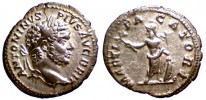
25 CaracallaCARACALLA
AR Denarius, 210-213 AD.
ANTONINVS PIVS AVG BRIT, laureate head right / MARTI PACATORI, Mars standing front, head left, holding olive-branch, reversed spear & shield
Sear 6818, RIC 222, RSC 149, BMC 81 VFSosius
|
|

279cfCarausius 287-93AD
AE Antoninianus
Obv: "IMP CARAVSIVS PF AVG"
Radiate, draped and cuirassed bust right
Rev: "MARS VICTOR"
Mars walking right holding spear with trophy over shoulder
Colchester mint
-/-//CXXI
RIC - (cf 279)
mauseus
|
|

4 TacitusTacitus. A.D. 275-276. Æ antoninianus (22.2 mm, 4.13 g, 6 h). Rome mint, A.D. 276. IMP CM CL TACITVS AVG, radiate and cuirassed bust right / MARTI PACIF, Mars advancing left, holding branch, spear and shield; S in exergue. RIC 145. gVF, partially silvered.
Ex. Agora Auctions, Aug 2014, from collection of Dave Surber, founder of wildwinds.comSosius
|
|

437Carausius 287-93AD
AE Antoninianus
Obv: "IMP CARAVSIVS PF AVG"
Radiate, draped and cuirassed bust right
Rev: "VIRTVS AVG"
Mars standing right leaning on shield
Colchester mint
-/-//CXXI
RIC 437
mauseus
|
|

437cfCarausius 287-93AD
AE Antoninianus
Obv: "IMP C CARAVSIVS PF AVG"
Radiate, draped and cuirassed bust right
Rev: "VIRTVS AVG"
Mars standing right leaning on shield
Colchester mint
S/C//C
RIC - (cf 437)mauseus
|
|

438cfCarausius 287-93AD
AE Antoninianus
Obv: "IMP CARAVSIVS P AVG"
Radiate, cuirassed bust left holding spear and shield
Rev: "VIRTVS AVG"
Mars standing right leaning on shield
Colchester mint
-/-//C
RIC - (cf 438)mauseus
|
|

439Carausius 287-93AD
AE Antoninianus
Obv: "IMP C M CARAVSIVS PF AVG"
Radiate, draped and cuirassed bust right
Rev: "VIRTVS AVG"
Mars standing right leaning on shield
Colchester mint
-/-//C
RIC 439mauseus
|
|

465cfCarausius 287-93AD
Antoninianus
Obv “IMP C CARAVSIVS P AVG”
Radiate, draped and cuirassed bust right
Rev “MARTI PACIFER”
Mars walking left holding branch, spear and shield
Uncertain mint
S/C//-
RIC - (cf 465-6)
mauseus
|
|

465cfCarausius 287-93AD
Antoninianus
Obv "IMP C CARAVSIVS PF I AVG"
Radiate, draped and cuirassed bust right
Rev "MARTI PACIFE"
Mars walking left holding branch, spear and shield
Uncertain mint
S/P//
RIC - (cf 465)mauseus
|
|

465cfCarausius 287-93AD
Antoninianus
Obv "IMP C CARAVSIVS P AVG"
Radiate, cuirassed bust right
Rev "MARTI PACIFE"
Mars walking left holding branch, spear and shield
Uncertain mint
S/C//
RIC - (cf 465)mauseus
|
|

527Carausius 287-93AD
AE antoninianus
Obv "IMP C CARAVSIVS PF AVG"
Radiate, draped and cuirassed bust right
Rev "VIRTVS AVG"
Mars walking right holding spear (and shield?)
S/C//-
Uncertain mint
RIC 527
mauseus
|
|

55AE sestertius
Trier Mint
IMP C POSTVMVS PF AVG
Laureate, draped and cuirassed bust right, rays incised into head
VIRTVS AVG
Mars standing right holding vertical spear and leaning on shield
Bastien 55
Incised rays on obverse in antiquity to try and pass the piece as a double sestertiusmauseus
|
|

69aVitellius 69 AD
AR denarius
Lugdunum mint
Obv "A VITELLIVS IMP GERMAN"
Laureate bust left
Rev "CONSENSVS EXERCITVVM"
Mars walking left
Lugdunum mint
RIC - (cf 51)
3.2 grammes, die axis 240 degreesmauseus
|
|

7 GallienusAE Antoninianus
IMP C P LIC GALLIENVS AVG, Radiate cuirassed bust right / VIRTVS AVGG, Mars standing left, leaning on shield at feet left, holding spear in left hand
RIC 181(j), Göbl 38 Sosius
|
|

7 GallienusGALLIENUS
AE Antoninianus, Rome Mint
261-262 AD
O: GALLIENVS AVG, Radiate bust r.
R: VIRTVS AVGVSTI, Mars standing l., holding olive branch and vertical spear, r. foot on helmet, X in l. field
Cunetio hoard 1278, Normanby hoard 264, Minster hoard 58,
Appleshaw hoard 68,
Göbl 0636a;
Lavilledieu hoard 53 & 54.
Cohen 1322
not in RIC
EF, worn reverse die
Sosius
|
|

81Domitian 81-96 AD
AE as
Obv "IMP CAES DOMIT AVG GERM COS XII CENS PER PP"
Laureate bust right
Rev "SC"
Mars advancing left
Rome mint
mauseus
|
|

841cfCarausius 287-93AD
Antoninianus
Obv "IMP CARAVSIVS PF AVG"
Radiate, draped and cuirassed bust right
Rev "M[ARS] VICT[O]"
Mars standing right with horse and holding vertical spear
Unmarked mint
RIC - (841cf)
mauseus
|
|

844Carausius 287-93AD
AE Antoninianus
Obv: "IMP CARAVSIVS P AVG"
Radiate, draped and cuirassed bust right
Rev: "MARS VICTOR"
Mars walking right with spear and trophy
Unmarked mint
RIC 844
mauseus
|
|

9 NumerianNUMERIAN
Silvered Antoninianus, Lyons Mint
IMP CM AVR NVMERIANVS AVG, Radiate bust r. / MARS VICTOR, Mars walking right, holding spear and trophy, retrograde C in r. field.
Lyons RIC V-2, 386, gVF fully silvered
Would clean up beautifully if I had the courage!Sosius
|
|
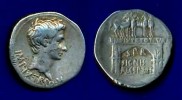
AUGUSTUS. AR Cistophorus (3 denarii) of Pergamum. Struck c.19 - 18 B.C.Obverse: IMP IX TR PO V. Bare head of Augustus facing right.
Reverse: Triumphal arch surmounted by Augustus in facing triumphal quadriga; IMP IX TR POT V on architrave; S P R SIGNIS RECEPTIS in three lines within arch opening, standards at either side.
RIC I : 510 | BMC : 703 | RSC : 298.
This coin commemorates Augustus' triumphant agreement with the Parthians in 20 B.C. under which they returned the legionary standards captured from Crassus who was defeated and killed at Carrhae thirty-three years earlier (53 B.C.) Augustus installed these standards in the Temple of Mars Ultor.
The reverse of the coin shows the triumphal arch which was awarded to Augustus on the occasion of his recovery of the standards. This was the second triumphal arch awarded to Augustus and, like the earlier arch which had been constructed in 29 BC to honour his victory over Cleopatra, this second arch, which archaeological evidence suggests may actually have incorporated the first arch, stood in close proximity to the Temple of Divus Julius at the southern entrance to the Roman Forum.
This is the rarest cistophorus struck during the reign of Augustus with the exception of the exceedingly rare issues featuring a sphinx.*Alex
|
|

Celtic CoinageContinental Celts & Tribes of Britannia
Gaul: Northwest Gaul: Aulerci Eburovices, Carnutes, Coriosolites, Redones, Senones, Veneti. Northeast Gaul: Ambiani, Remi, Suessiones (Cricironus), Treveri.
Central Gaul: Aediu, Arverni. Sequani (Turonos & Cantorix). Southern Gaul: Massalia (Marseilles), Tolostates, Volcae-Arecomici. Uncertain: Volcae Tectosages, Leuci, Senones.
Britain: Atrebates & Regni (Verica), Cantii (Amminus), CantuvellauniCorieltauvi (Volisios Dumnocoveros), Cunobelin, Dobunni, Durotriges, Epaticcus, Iceni, Trinovantes, Cantuvellauni & Trinovantes (Addedomaros, Caratacus).
Lower Danube: Geto-Dacians. Middle Danube: Hercuniates. Central Europe: Boii. Danubian Celts are also referred to as being from the Carpathian Region, in which there were various tribes, many unknown. Anaximander
|
|

Constantine I, RIC VII 124 TicinumObverse: IMP CONSTANTINVS PF AVG, laureate and cuirassed bust right.
Reverse: MARTI CONSERVATORI, Mars in military dress standing right with spear in hand with point on ground and his left hand on shield set on the ground, cloak across right shoulder. .
19. mm., 2.5 g. Mintmark: S dot T Ticinum mint.
NORMAN K
|
|

Gallienus, RIC 236 RomeGallienus, AE antoninianus 253-268 CE
Obverse: GALLIENVS AVG, radiate, bust right.
Reverse: MARTI PACIFERO, Mars standing left, holding olive branch, spear and shield. H in left field.
16.4 mm., 2.0 g.NORMAN K
|
|

Gordian III AR AntoninianusIMP GORDIANVS PIVS FEL AVG, his radiate and cuirassed bust right .
MARS PROPVG, Mars hastening right, holding shield & spear. RIC 145, RSC 155. Britanikus
|
|

Septimius Severus Denarius, RIC 46, RSC 311, BMC 84 Septimius Service Denarius. Struck 194-195 C.E.
Obverse - L SEPT SEV PERT AVG IMP IIII. Laureate head right.
Reverse - MARS PATER. Mars walking right, holding spear in right hand, Trophy over left shoulder.
17.5 mm., 3.3 g.
sold 3-2018NORMAN K
|
|

ROME
PB Tessera (12mm, 1.25 g, 2 h)
Mars advancing left, holding spear over shoulder
Boar
Rostowzew -; München 26Ardatirion
|
|

ROME
PB Tessera (17mm, 2.38 g, 12h)
Mars standing left, holding Victory and spear
Fly
Rostovtsew 188
Ex Classical Numismatic Group 55 (13 September 2000), lot 1201 (part of)Ardatirion
|
|

ROME. First Cohort.
PB Tessera (21mm, 4.40 g, 12h)
Soldier (or Mars) standing facing, head left, holding spear and resting shield on ground
C I (Cohors Prima)
Rostovtsev 246 = Rostovtsev & Prou 40dArdatirion
|
|

ROME
PB Tessera (19mm, 2.71 g, 12 h)
Imperial issue (?)
Venus Victrix standing right, resting arm on cippus and holding transverse scepter and clasping hands with Mars, standing left
Fortuna standing left, holding rudder and cornucopia
Rostowzew 153, pl. III 2; München 16-7; Kircheriano 572, 582, 738, and 741
Rostowzew places this with the "Tesserae capitibus et nominibus imperatorum signatae" on the basis of type. In my studies, I have noticed that many of the types bearing Imperial portraiture or names are much more finely engraved, often with a centering dot and pronounced rims.Ardatirion
|
|

ROME. temp. Hadrian-Antoninus Pius. Circa AD 120-161
Æ Quadrans (16mm, 2.94 g, 7h)
Rome mint
Petasus
Winged caduceus; S C flanking
Weigel 18; RIC II 32; Cohen 36
Weigel reconsiders the anonymous quadrantes as a cohesive group. The seriesportrays a pantheon of eleven deities: Jupiter, Minerva, Roma, Neptune, Tiber, Mars, Venus, Apollo, Mercury, Bacchus/Liber, and Hercules. Types are primarily a portrait of the god, with an attribute on the reverse and are usually influenced by (but not directly copied from) earlier designs, primarily from the Republic. He updates the series to the reigns of Hadrian and Antoninus.Ardatirion
|
|

ROME. temp. Domitian-Antoninus Pius. Circa AD 81-160
Æ Quadrans (16mm, 3.99 g, 12 h)
Rome mint
Griffin seated left, paw on wheel
Tripod; S C flanking
Weigel 15; RIC II 28; Cohen 38
Weigel reconsiders the anonymous quadrantes as a cohesive group. The seriesportrays a pantheon of eleven deities: Jupiter, Minerva, Roma, Neptune, Tiber, Mars, Venus, Apollo, Mercury, Bacchus/Liber, and Hercules. Types are primarily a portrait of the god, with an attribute on the reverse and are usually influenced by (but not directly copied from) earlier designs, primarily from the Republic. He updates the series to the reigns of Hadrian and Antoninus.Ardatirion
|
|

RIC.93 Postumus: antoninianus (Virtvs Avg)Postumus, Gallic emperor (usurper) (260-269)
Antoninianus: Virtvs Avg (2ond emission, 2ond phase, 262, Trèves)
Billon (200 ‰), 3.39 g, diameter 22 mm, die axis 2h
A/ IMP C POSTVMVS P F AVG; radiate, draped and cuirassed bust right
R/ VIRT-VS AVG; Mars standing right, holding spear and leaning on shield
EG.35
|
|

RIC.57 Postumus: antoninianus (P M TR P IIII COS III P P)Postumus, Gallic emperor (usurper) (260-269)
Antonianus: P M TR P IIII COS III P P (3rd émission, 1st phase, 263-265, Trèves)
Billon (150 ‰), 4.27 g, diameter 21 mm, die axis 1 h
A/ IMP C POSTVMVS P F AVG; radiate, draped and cuirassed bust right
R/ PP M TR P-IIII-COS III PP; Mars walking right with spear and trophy.
EG.36
|
|

RIC.148 Tetricus I: antoninianus (Virtvs Avgg)Tetricus, Gallic emperor (usurper) (271-274)
Antoninianus: Virtvs Avgg (5th emission, 274, Trèves)
Billon, 2.92 g, diameter 19 mm, die axis 7h
A/ IM[P C T]ETRI[C]VS P F AVG; radiate, draped and cuirassed bust right
R/ VIRTVS AVGG, Mars standing left, holding spear and leaning on shield
EG.281
|
|

LT abs, Gaul, MassaliaMassalia (Marseille, south of France)
Circa 385-310 BC ?
Silver obol, 0.67 g, 10 mm diameter, die axis 8h
O/ youthful head of Apollo, right, with a visible ear and sideburns
R/ wheel with four spokes, M and A in two quarters
Marseille was founded by the Phocean Greeks circa 600 BC. This obol has obviously more greek than celtic origins.
|
|
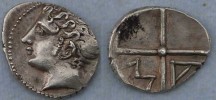
LT 681, Gaul, MassaliaMassalia (Marseille, south of France)
Circa 225-100 BC ?
Silver obol, 0.59 g, 11 mm largest diameter, die axis 11h
O/ youthful head of Apollo, left, with a visible ear and sideburns
R/ wheel with four spokes, M and A with small bullets in two of the quarters
|
|

(0177) COMMODUS177 - 192 AD
Struck 179 - 180
AE As 24 mm 9.90 g
O: L AVREL COMMODVS AVG, laureate bust right, draped and cuirassed
R: TR P V IMP III COS II P P, S-C, Commodus advancing right, holding spear and trophy
Rome; RIC 293laney
|
|

(0198) CARACALLA198-217 AD
struck 196-197 (as Caesar)
AE 25 mm, 9.32 g
O: Bare headed draped bust right
R: Mars advancing right with spear and tropy over shoulder/S-C
Rome; RIC 402 (rare)laney
|
|

(0218) ELAGABALUS218 - 222 AD
AE 24 mm; 11.06 g
O: Laureate, draped bust of Elagabalus right.
R: Statue of Marsyas standing right, holding wine skin over shoulder and extending arm, within arched gateway
Phoenicia, Berytuslaney
|
|

(0218) ELAGABALUS218 - 222 AD
AE 24 mm; 10.3 g
O: Laureate, draped bust of Elagabalus right.
R: Statue of Marsyas standing right, holding wine skin over shoulder and extending arm, within arched gateway
Phoenicia, Berytuslaney
|
|

(0218) ELAGABALUS218 - 222 AD
AE 24 mm; 8.10 g
O: Laureate, draped, and cuirassed bust right
R: The satyr Marsyas standing on pedestal playing pipes within arch of a tetrastule temple.
Phoenicia, Berytos.
Lindgren 2269 laney
|
|

(0218) ELAGABALUS218 - 222 AD
AE 24 mm; 11.15 g
O: Laureate, draped bust right
R: COL LAODIC--, Marsyas standing left, wine-skin over shoulder, right hand raised, D-E across fields
Syria, Laodicea ad mare; cf. Lindgren Coll. I, 2095laney
|
|

(0222) SEVERUS ALEXANDER222-235 AD
Struck 228 AD
AE Sestertius 28 X 30 mm, 21.99 g
O: IMP CAES AVT SEV ALEXANDER AVG laureate draped cuirassed bust right
R: _PM TRP_COS_/ SC Mars walking right holding spear and trophy over shoulder
Rome; cf RIC 456laney
|
|

(0222) SEVERUS ALEXANDER232 AD
AE Sestertius 30 mm max.; 23.06 g
O:IMP ALEXANDER PIVS AVG - Laureate bust right, seen from front, draped and cuirassed.
R: MARS VLTOR - Mars with advancing right with spear and shield; S/C
Rome
laney
|
|

(0253) GALLIENUS253-268 AD
AE 18.5 mm
O: radiate bust right
R: Mars standing left holding spear and leaning on shieldlaney
|
|

(0253) GALLIENUS253 - 268 AD
AE 17 mm; 2.95 g
O: [GALLIENVS AVG] Radiate head, right.
�R: MARTI PACIFEROMars standing left, holding olive-branch, spear and shield, A in right field.
Rome, RIC 236
�
Mint City: Rome. Struck AD 264-66�
Reference: Goebl 570a. RIC 236.
laney
|
|

(0253) GALLIENUS253-268
struck 260 - 268
AE 16.8 mm 2.30 g
Obv: GALLIENVS AVG, radiate bust right.
Rev: MARTI PACIFERO, Mars standing left, holding branch in right hand, and spear with shield in left hand. laney
|
|

(0268) CLAUDIUS II (GOTHICUS)268 - 270 AD
AE ANT. 20.5 mm 3.75 g
O: IMP C CLAVDIVS AVG
RAD BUST R
R: MARS VLTOR
MARS WALKING R HOLDING SPEAR AND TROPHY
RIC 66 VAR.laney
|
|

(0268) CLAUDIUS II GOTHICUS268 - 270 AD
AE 17.5 mm max. 2.47 g
O: IMP CLAVDIVS AVG, radiate and cuirassed bust right;
R: MARS VLTOR, Mars walking right, holding spear in right hand and spear across shoulder in left, H in right field
Rome mint; RIC V 67
(EB)
laney
|
|

(0268) CLAUDIUS II GOTHICUS268 - 270 AD
Billon antoninianus, silvered. 17 X 19 mm; 2.27 g
O: IMP C CLAVDIVS AVG, radiate draped bust right
R: VIRTVS AVG, Virtus (Mars) standing left, holding branch and sceptre, shield left at feet
Rome mint; cf RIC 109laney
|
|

(0276) PROBUS276 - 282 AD
AE 22 mm, 3.25 g
O: IMP C M AVR PROBVS P F AVG, radiate bust left in imperial mantle, holding sceptre surmounted by eagle.
R: VIRTVS PROBI AVG, Mars walking right, holding spear and trophy; T in lower right field; XXI in exe.
Siscia mint
laney
|
|

(0317) CRISPUS317 - 326 AD
struck 317 AD.
AE 17.5 mm 3.25 g
O: CRISPUS NOB CAES, laureate, draped bust facing right.
R: PRINCIPIA IVVENTVTIS, Mars standing right, chlamys over right shoulder, holding scepter in right hand, leaning on shield.
R S in fields
ARLES MINT, (rare) cf. RIC VII 132-133
laney
|
|

(502a) Roman Republic, L. Calpurnius Piso Frugi, 90 B.C.Silver denarius, S 235, Calpurnia 11, Crawford 340/1, Syd 663a, VF, rainbow toning, Rome mint, 3.772g, 18.5mm, 180o, 90 B.C. obverse: laureate head of Apollo right, scorpion behind; Reverse naked horseman galloping right holding palm, L PISO FRVGI and control number CXI below; ex-CNA XV 6/5/91, #443. Ex FORVM.
A portion of the following text is a passage taken from the excellent article “The Calpurnii and Roman Family History: An Analysis of the Piso Frugi Coin in the Joel Handshu Collection at the College of Charleston,” by Chance W. Cook:
In the Roman world, particularly prior to the inception of the principate, moneyers were allotted a high degree of latitude to mint their coins as they saw fit. The tres viri monetales, the three men in charge of minting coins, who served one-year terms, often emblazoned their coins with an incredible variety of images and inscriptions reflecting the grandeur, history, and religion of Rome. Yet also prominent are references to personal or familial accomplishments; in this manner coins were also a means by which the tres viri monetales could honor their forbearers. Most obvious from an analysis of the Piso Frugi denarius is the respect and admiration that Lucius Calpurnius Piso Frugi, who minted the coin, had for his ancestors. For the images he selected for his dies relate directly to the lofty deeds performed by his Calpurnii forbearers in the century prior to his term as moneyer. The Calpurnii were present at many of the watershed events in the late Republic and had long distinguished themselves in serving the state, becoming an influential and well-respected family whose defense of traditional Roman values cannot be doubted.
Lucius Calpurnius Piso Frugi, who was moneyer in 90 B.C., depicted Apollo on the obverse and the galloping horseman on the reverse, as does his son Gaius. However, all of L. Piso Frugi’s coins have lettering similar to “L-PISO-FRVGI” on the reverse, quite disparate from his son Gaius’ derivations of “C-PISO-L-F-FRV.”
Moreover, C. Piso Frugi coins are noted as possessing “superior workmanship” to those produced by L. Piso Frugi.
The Frugi cognomen, which became hereditary, was first given to L. Calpurnius Piso, consul in 133 B.C., for his integrity and overall moral virtue. Cicero is noted as saying that frugal men possessed the three cardinal Stoic virtues of bravery, justice, and wisdom; indeed in the Thesaurus Linguae Latinae, a synonym of frugalitas is bonus, generically meaning “good” but also implying virtuous behavior. Gary Forsythe notes that Cicero would sometimes invoke L. Calpurnius Piso’s name at the beginning of speeches as “a paragon of moral rectitude” for his audience.
L. Calpurnius Piso Frugi’s inclusion of the laureled head of Apollo, essentially the same obverse die used by his son Gaius (c. 67 B.C.), was due to his family’s important role in the establishment of the Ludi Apollinares, the Games of Apollo, which were first instituted in 212 B.C. at the height of Hannibal’s invasion of Italy during the Second Punic War. By that time, Hannibal had crushed Roman armies at Cannae, seized Tarentum and was invading Campania.
Games had been used throughout Roman history as a means of allaying the fears
of the populace and distracting them from issues at hand; the Ludi Apollinares were no different. Forsythe follows the traditional interpretation that in 211 B.C., when C. Calpurnius Piso was praetor, he became the chief magistrate in Rome while both consuls were absent and the three other praetors were sent on military expeditions against Hannibal.
At this juncture, he put forth a motion in the Senate to make the Ludi Apollinares a yearly event, which was passed; the Ludi Apollinares did indeed become an important festival, eventually spanning eight days in the later Republic. However, this interpretation is debatable; H.H. Scullard suggests that the games were not made permanent until 208 B.C. after a severe plague prompted the Senate to make them a fixture on the calendar. The Senators believed Apollo would serve as a “healing god” for the people of Rome.
Nonetheless, the Calpurnii obviously believed their ancestor had played an integral role in the establishment of the Ludi Apollinares and thus prominently displayed
the head or bust of Apollo on the obverse of the coins they minted.
The meaning of the galloping horseman found on the reverse of the L. Calpurnius Piso Frugi coin is more complicated. It is possible that this is yet another reference to the Ludi Apollinares. Chariot races in the Circus Maximus were a major component of the games, along with animal hunts and theatrical performances.
A more intriguing possibility is that the horseman is a reference to C. Calpurnius Piso, son of the Calpurnius Piso who is said to have founded the Ludi Apollinares. This C. Calpurnius Piso was given a military command in 186 B.C. to quell a revolt in Spain. He was victorious, restoring order to the province and also gaining significant wealth in the process.
Upon his return to Rome in 184, he was granted a triumph by the Senate and eventually erected an arch on the Capitoline Hill celebrating his victory. Of course
the arch prominently displayed the Calpurnius name. Piso, however, was not an infantry commander; he led the cavalry.
The difficulty in accepting C. Calpurnius Piso’s victory in Spain as the impetus for the galloping horseman image is that not all of C. Piso Frugi’s coins depict the horseman or cavalryman carrying the palm, which is a symbol of victory. One is inclined to believe that the victory palm would be prominent in all of the coins minted by C. Piso Frugi (the son of L. Calpurnius Piso Frugi) if it indeed signified the great triumph of C. Calpurnius Piso in 186 B.C. Yet the palm’s appearance is clearly not a direct reference to military feats of C. Piso Frugi’s day. As noted, it is accepted that his coins were minted in 67 B.C.; in that year, the major victory by Roman forces was Pompey’s swift defeat of the pirates throughout the Mediterranean.
Chrestomathy: Annual Review of Undergraduate Research at the College of Charleston. Volume 1, 2002: pp. 1-10© 2002 by the College of Charleston, Charleston SC 29424, USA.All rights to be retained by the author.
http://www.cofc.edu/chrestomathy/vol1/cook.pdf
There are six (debatably seven) prominent Romans who have been known to posterity as Lucius Calpurnius Piso:
Lucius Calpurnius Piso Frugi: (d. 261 A.D.) a Roman usurper, whose existence is
questionable, based on the unreliable Historia Augusta.
Lucius Calpurnius Piso Licinianus: deputy Roman Emperor, 10 January 69 to15 January
69, appointed by Galba.
Lucius Calpurnius Piso: Consul in 27 A.D.
Lucius Calpurnius Piso: Consul in 1 B.C., augur
Lucius Calpurnius Piso: Consul in 15 B.C., pontifex
Lucius Calpurnius Piso Caesoninus: Consul in 58 B.C. (the uncle of Julius Caesar)
Lucius Calpurnius Piso Frugi: Moneyer in 90 B.C. (our man)
All but one (or two--if you believe in the existence of "Frugi the usurper" ca. 261 A.D.) of these gentlemen lack the Frugi cognomen, indicating they are not from the same direct lineage as our moneyer, though all are Calpurnii.
Calpurnius Piso Frugi's massive issue was intended to support the war against the Marsic Confederation. The type has numerous variations and control marks.
http://en.wikipedia.org/wiki/Lucius_Calpurnius_Piso
http://www.forumancientcoins.com/catalog/indexfrm.asp?vpar=55&pos=0
Edited by J. P. Fitzgerald, Jr.
Cleisthenes
|
|
| 2089 files on 24 page(s) |
1 |
 |
 |
 |
 |
|

|
